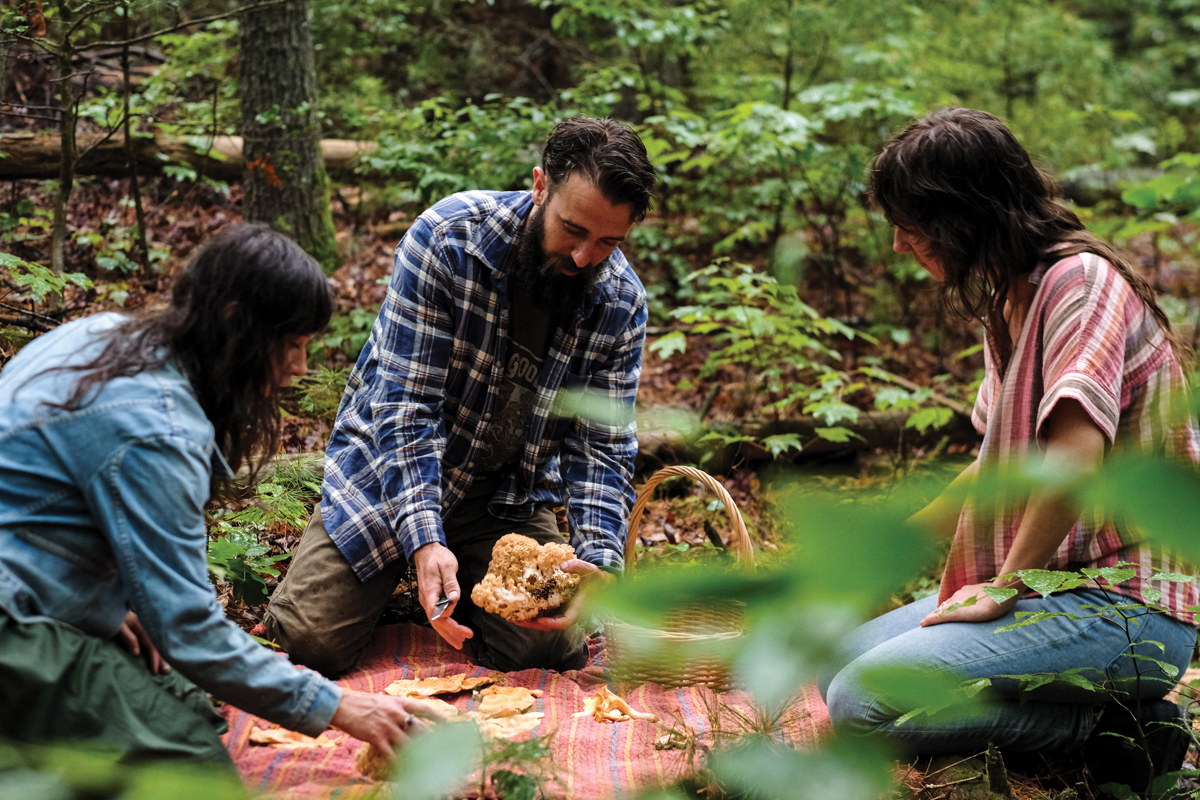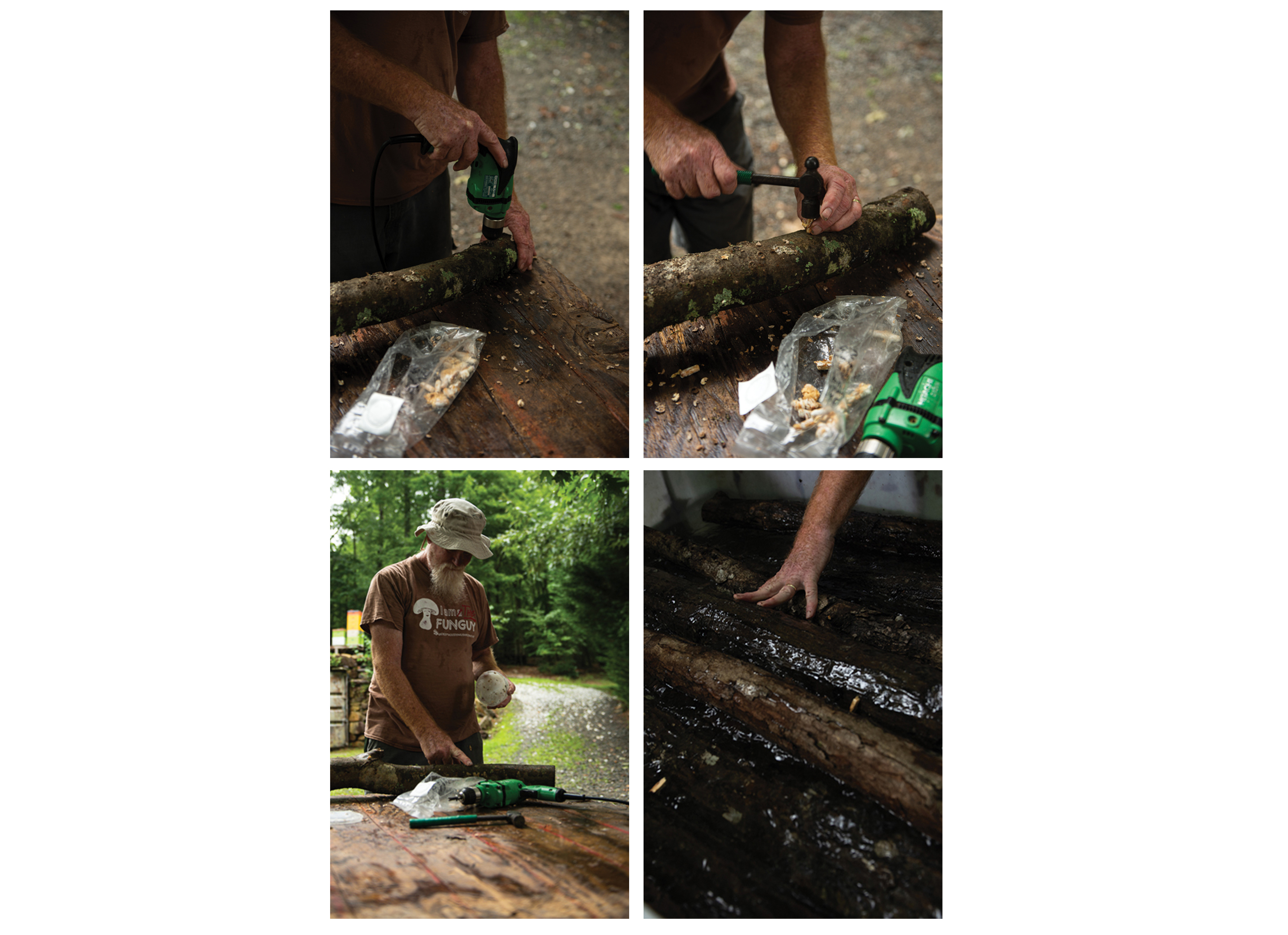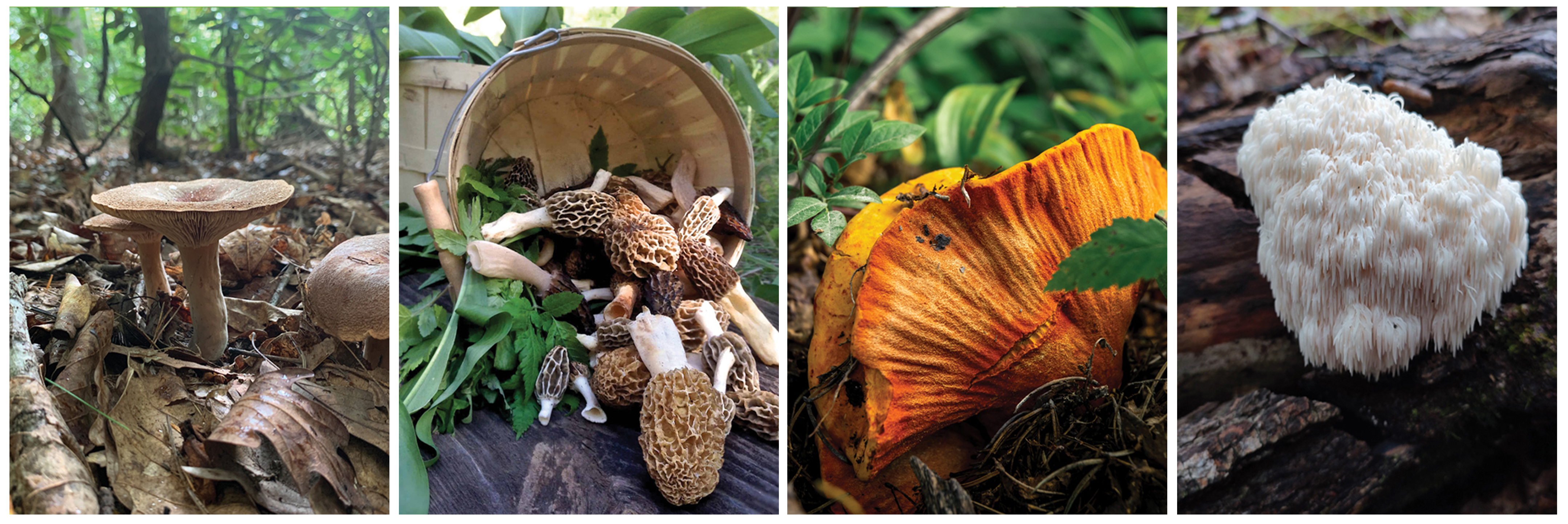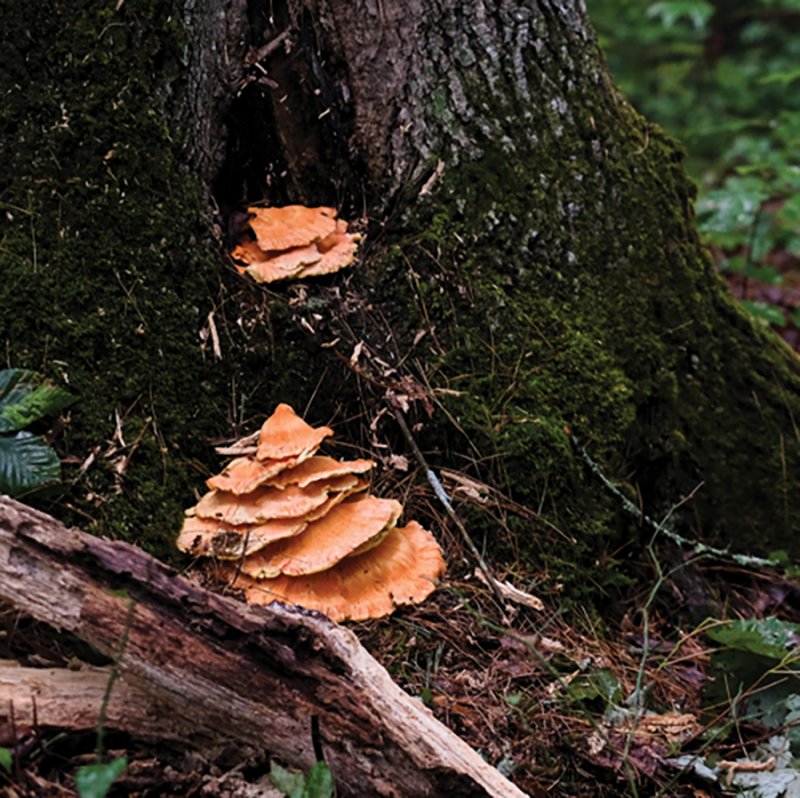In Search of Mushrooms
In Search of Mushrooms: Abundantly growing in Appalachia, fungi can be found throughout WNC. Here’s our guide to safely finding—and growing—your own in our backyard.
You may find one poking up from underneath the duff, like a tiny gnome-home. Or perhaps you’ll look up and see one fanning out of a tree, like a UFO that’s docked on the bark. With diverse shapes, sizes, colors, and textures, mushrooms are abundant in our wild mountains, and many of them are edible, medicinal, or both.
All of them, even the mushrooms that aren’t directly “useful” to humans, are busy turning dead trees into soil, transforming nutrients into forms that plants can take in, passing chemical messages throughout the ecosystem, and doing other mysterious and wonderful things.
Wild mushrooms are both fascinating and useful, and our home is an ideal region for gathering and getting to know them. This abundance of fungi (the broader group that mushrooms are a part of) is due to a combination of topography, climate, and a general biodiversity in our area. The majority of the bodies of fungi exist underground or within trees as a web-like structure called mycelium; this part is huge compared with the mushrooms we see. What we like to pick are actually like fruits that grow from the vast mycelial networks, themselves akin to roots and branches.
In their book Mushrooms of the Southeast, Todd Elliott and Steven Stephenson share that “The mixed forests of [our region] are the most biodiverse temperate forests in the world, with more tree species than all of Europe!” And where there are trees, there are mushrooms. That’s because many mushrooms have mutually beneficial relationships with tree roots. In this arrangement, the trees offer shade and share sugars, while the mushrooms transform and transport nutrients from the soil into hungry roots; this group of fungi are called mycorrhizae. Indeed, studies show that over 90% of plants have relationships with mycorrhizae.
Fungi Fact: Mushrooms breathe in oxygen and breathe out carbon dioxide, just like us! In many ways, mushrooms are more similar to animals than to plants.
According to Alan Muskat, local forager, philosopher, educator, and founder of No Taste Like Home foraging tours, who’s been friendly with fungi for over 30 years, “It’s believed, though not necessarily accepted, that trees were invented by fungi, in order to create shade; mushrooms were there first.” Putting aside the chicken-or-the-egg quandary, it’s clear that healthy, moist, biodiverse forests harbor the most mushrooms.
Natalie Dechiara, mushroom forager, educator, concocter and director of operations at Wild Goods Foraged Foods notes another key feature of our region that helps mushrooms abound, “I love this mountainous area because it, somewhat, prevents humans from completely developing every square inch.” Since the steep terrain around here keeps humans from building houses everywhere, forests, fungi, and many other beings are left with enough wild lands to thrive.

When hunting for mushrooms, trees often house a variety of fungi. Depending on the species involved, the tree and mushroom can either be in a symbiotic relationship, or the mushroom could be parasitically preying on the tree’s nutrients.
Foraging
Foraging mushrooms is a fun and rewarding way to get to know the living world more intimately, while also coming home with something delicious to eat. You can find wild mushrooms year-round in WNC, but the most abundant seasons are late-spring through mid-fall, with different kinds of mushrooms preferring different temperatures and conditions. Hardwood forests are often hotbeds of tasty mushrooms, but fungi also grow in disturbed areas, pine forests, and even residential neighborhoods. The best way to approach foraging is to go outside often and pay attention, remaining open to what you might find. “With foraging it’s very easy to find what you’re not looking for. The less picky you are while you pick, the more chances for feeling provided for, feeling abundant,” says Muskat.
Exploring the world of mushrooms is free and available to anyone, however if you’d like to harvest and eat what you find, it’s absolutely essential to know what you’re doing: some mushrooms have toxic compounds that can make you sick, or even kill you. “It’s perfectly easy to be safe foraging for mushrooms the day that you start,” Muscat reassures us. “The only way to do that is to go out with an expert. The way to not do that . . . is to buy a book or an app.” Dechiara echoes this sentiment about the importance of learning to identify mushrooms directly from a person. “You need to learn from someone who has the skill. It’s a tradition that, throughout time, has been passed down through culture and through families.” She adds, “the apps are awful. They are completely inaccurate. I’ve seen them misidentify mushrooms more often than I’ve seen them get it right.” In her opinion, one of the first steps in learning to identify mushrooms is actually to learn how to identify trees, since “the best eating mushrooms are associated with living trees.” Both Muskat and Dechiara agree that books can be great reference material for foragers at all levels, but they don’t take the place of human guidance.
Along with proper identification, Dechiara notes that the growing conditions and preparation of mushrooms can impact how safe they are to eat. Mushrooms are bioaccumulators that concentrate toxins. This is great when they’re used to help clean up polluted areas, but it’s a bad idea to eat mushrooms that have grown close to roads or near poisoned runoff. Nearly all mushrooms must be cooked before you eat them. In fact, the very popular morel mushroom contains deadly hydrazine when it’s raw, and the most recent mushroom-related death in the US was due to raw morels being served in a sushi roll.
Fungi Fact: Foraging traditions still thrive in many parts of the world, including Eastern Europe, Italy, Japan and Russia.
We’re lucky to have lots of mushroom experts who are passionate about teaching in our area, including Muskat, Dechiara, Greg Carter of Deep Woods Mushrooms, who I also interviewed, and many others. Like the fungi they’re fond of, these folks happily share what they know and readily create connections between curious humans and the forests where we dwell. As Carter puts it “I want people to be better growers and foragers than me. I’ll give them all the information from my 20 years of experience.” Check out the list of mushroom foraging classes and teachers to find your mushroom mentor. Additionally, Dechiara attends several farmer’s markets each week, offering wild-foraged mushroom products like compound butters, salts, patés and more. She invites budding foragers to bring mushrooms to the market, where she’ll be happy to take a look and help ID after she serves her customers. Wild Goods, Dechiara and her husband Luke Gilbert’s business, is regularly at the Asheville City Market, the River Arts District market and several others; check their website for specific info.

(Clockwise from top left) 1. After collecting logs and letting them rest for a few weeks, drill your holes; 2. Hammer the mushroom spawn from your kit into the hole you drilled; 3. Once the mushrooms are in place, cover the hole with wax to seal them into the log.Wait several months to allow for growth; 4. Soak your logs in water to encourage the fungi to sprout through the wood to be harvested.
Growing
Another way to get more mushrooms onto your plate is to grow them yourself. Doing this on inoculated logs is fairly easy and quite fruitful. Carter, who sells homegrown mushrooms at the Transylvania County tailgate market and teaches log inoculation classes says “To grow mushrooms, you understand how they grow in nature and then you’re mimicking mother nature.”
The basic steps of this process are to cut healthy, living trees into logs, let them sit for a couple of weeks in a moist, shady spot, then drill holes of a specific size and depth into them. To these holes you add mushroom “spawn” (mycelium of the mushroom you’re trying to grow), cover the holes with wax, allow the mycelium to colonize the logs for several months in a shady, moist environment and await fruiting. Once the mycelium has colonized the logs, water saturation will stimulate fruiting. You can either wait for a good rain, or dunk or soak your logs to get them to fruit. Logs prepared like this can yield many pounds of delicious mushrooms, seasonally, for three to five years with pretty minimal care.
Fungi Fact: Reishi mushrooms are also called the "mushroom of immortality" because they are such a powerful medicinal
Along with teaching classes on log inoculation, Carter sells kits with everything you need to inoculate 15 logs, including a special drill bit, “plug spawn” for three different strains of shiitake mushrooms, wax, and tags. He doesn’t provide logs, so you’ll have to harvest these yourself. Not just any log will do. For growing shiitakes, oak is the preferred type of wood. Young trees between three and eight inches in diameter, cut when they’re dormant are ideal. This means harvesting a healthy, living tree in the winter, before buds form. You can find lots of great educational information about growing mushrooms, plus equipment and spawn, at Field and Forest (fieldforest.net). Carter is a Field and Forest distributor and Deep Woods Mushrooms used to be the southern test facility for them.

Happy Hunting
Now that you’re ignited with interest about the world of fungi, here’s a list of the top 15 varieties to get to know while you wander the woods of Western North Carolina >>READ MORE
Resources - Where to find expert advice on mushroom foraging
Books
How to Forage Mushrooms Without Dying: An Absolute Beginner’s Guide to Identifying 29 Wild, Edible Mushrooms by Frank Hyman, who lives, writes, and teaches about foraging in Durham.
Mushrooms of the Southeast by Todd F. Elliott and Steven L. Stephenson. A thorough and easy-to-navigate regional guidebook.
A Field Guide to Mushrooms of the Carolinas by Alan E. Bessette, Arlene R. Bessette and Michael W. Hopping. A robust guide that includes an overview of our region’s role in American mycology.
Wild Mushrooms: A Taste of Enchantment Ebook by Alan Muskat (free at notastelikehome.org). A dive into the nature of fungi and the philosophy of foraging.
Mushroom Foraging Classes and Teachers
No Taste Like Home
Wild food strolls every Thursday morning (no one turned away for lack of funds). Morel mushroom and ramp (wild leek) tours in April. Backyard wild edibles consultations. notastelikehome.org
Wild Goods
Guided mushroom foraging walks every third Sunday from June through October. Winter foraging and log inoculation classes. wildgoods.org
Deep Woods Mushrooms
Wild edible mushroom hunts by appointment. Log inoculation classes and kits. deepwoodsmushrooms.net
Blue Ridge Chaga Connection
Wild foraging walks and ID walks at private residences by appointment. blueridgechagaconnection.com
Astounding Earth.
Mushrooms of the Southern Appalachian 7-week series August through October. Winter classes and private classes. astoundingearth.com
Visit our website for mushroom recipes, extra resources, and more on our local fungi.
